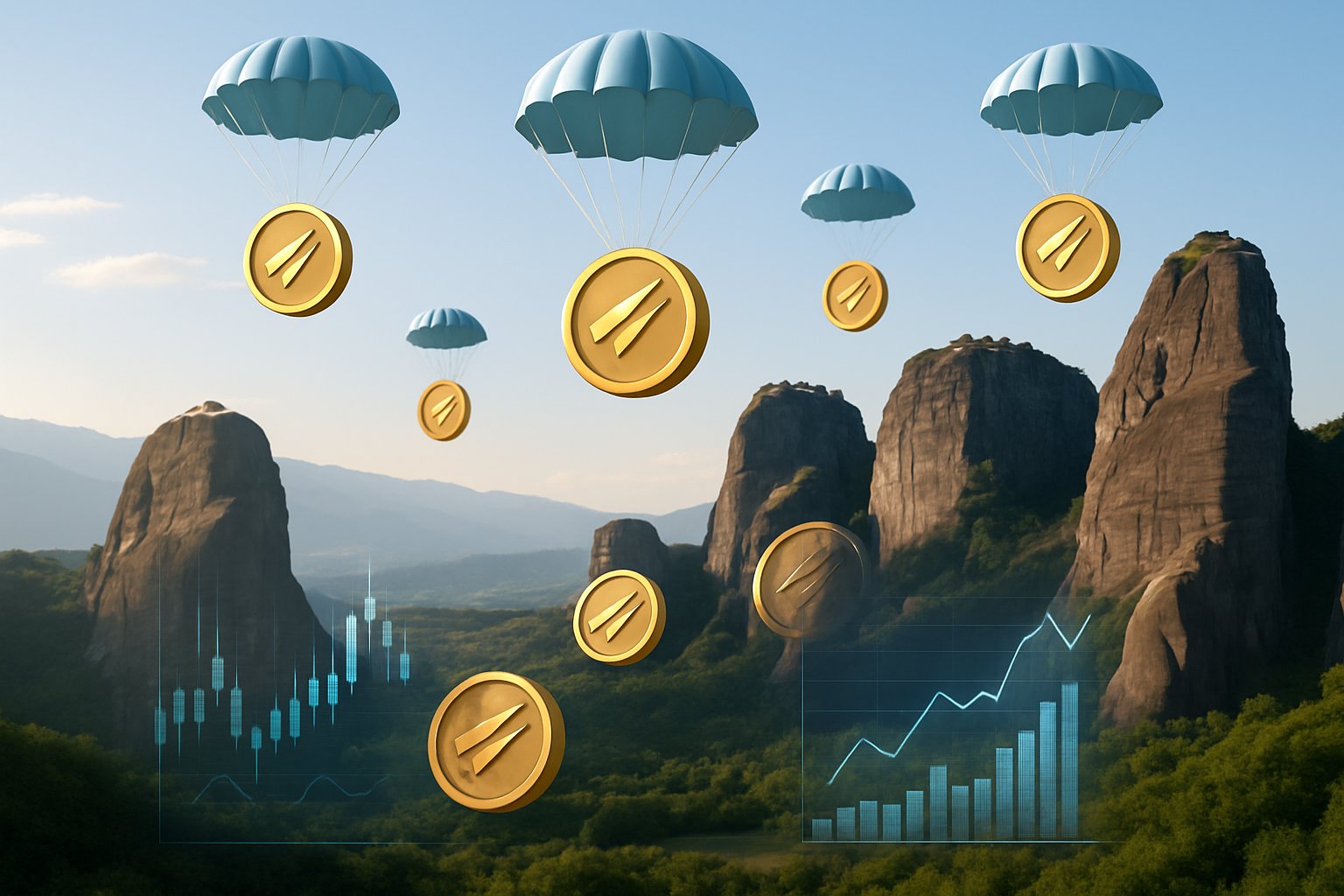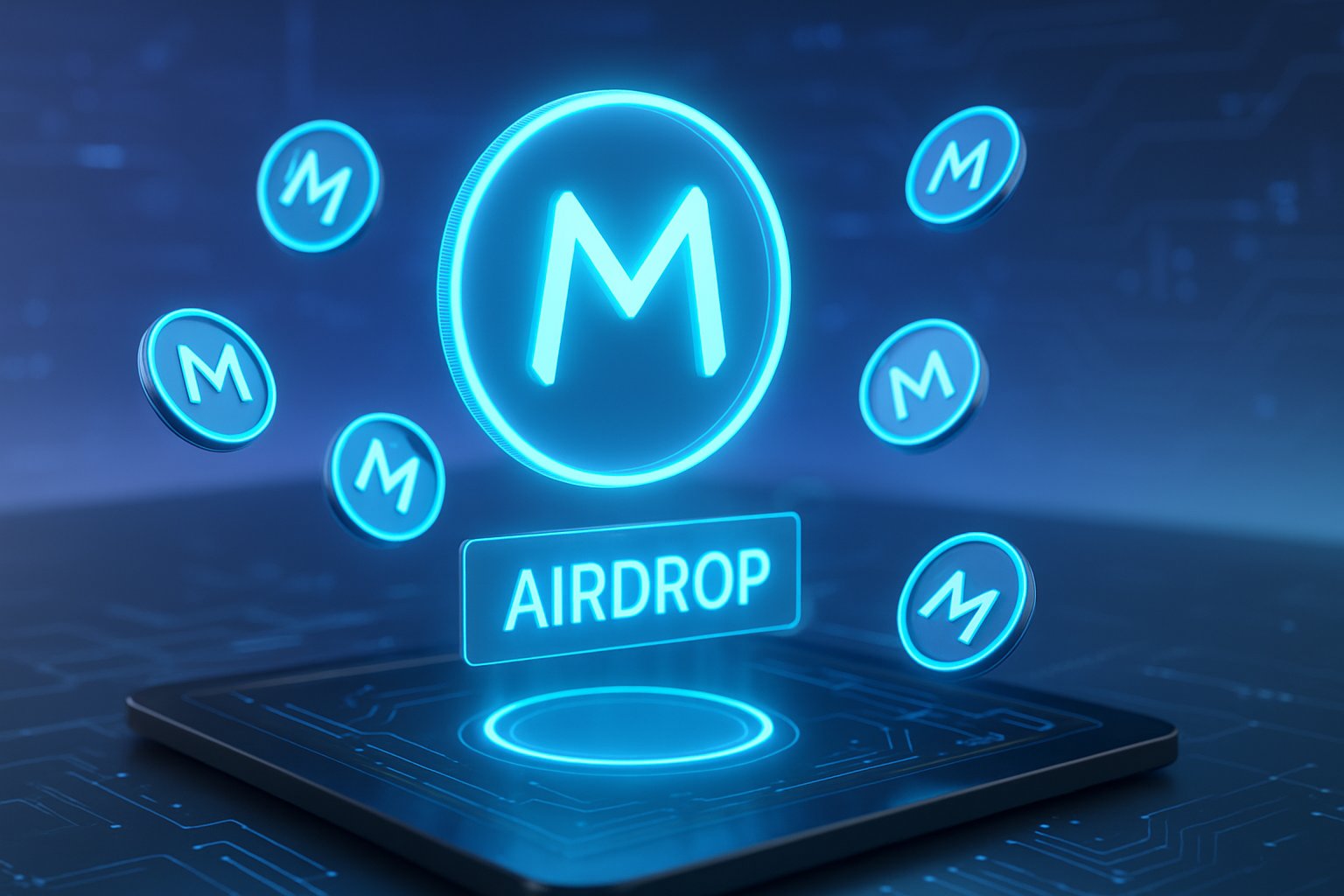
Meteora’s airdrop has become a hot topic in the crypto world, especially as more users try to maximize their points for potential rewards. As one of the most underrated airdrops in the DeFi space, many investors are closely watching its price movements and distribution mechanics.

Today’s Airdrop Checker Even: Step-by-Step Claim:
🌐 Step 1: Visit the Official Airdrop Reward Page.
Dive into the action by heading to the official airdrop page, where all live events are waiting for you. Log into your account by connecting your wallet from any MOBILE/DESKTOP DEVICE.
📱 Step 2: Use Your Mobile Wallet or Desktop
Eligibility checks are mobile or desktop! Grab your smartphone and ensure you’re using a wallet to participate.
💎 Step 3: Meet The Eligibility Criteria
Make sure your wallet isn’t empty or brand new—only active wallets qualify. If one doesn’t work, don’t worry! Try again with another wallet to secure your rewards. You can claim many rewards from multiple wallets, so try to use multiple wallets to increase your chance to claim.
💰 Step 4: Withdraw The Tokens
After signing the approval from your wallet, wait 5 to 10 minutes, and then congratulations! You will see a token claim in your wallet. You can easily exchange your tokens from SushiSwap, PancakeSwap, and many more.
Meteora (MET) represents DeFi’s first dynamic yield infrastructure, focusing on liquidity tasks that could create significant value for early participants. The platform’s growing popularity is evident in its impressive 24-hour trading volumes, with some trading pairs showing volumes exceeding $49 million.
While many crypto enthusiasts have confirmed the airdrop is live, understanding how to optimize participation remains challenging for most. The platform’s design as yield infrastructure suggests the potential value could be tied to its utility within the DeFi ecosystem, making it an interesting project to watch as prices develop.
Overview of Meteora Airdrop

Meteora’s airdrop program aims to distribute tokens to active users and provide liquidity on the Solana blockchain. The initiative includes both MET tokens and a memecoin stimulus, serving as a key element in Meteora’s mission to enhance Solana’s liquidity landscape.
Key Details About the Airdrop
Meteora has confirmed an airdrop allocation of 10% for Meteora users and 2% for a memecoin stimulus. This distribution helps fulfill the platform’s primary mission to “make Solana liquid again.” The token being distributed is MET, Meteora’s native token.
The airdrop also includes M3M3 tokens specifically for active ecosystem users. This dual-token approach demonstrates Meteora’s commitment to rewarding different types of participation within their ecosystem.
While the exact reward date remains TBA (To Be Announced), users can earn points toward potential rewards. The estimated time investment for participation is approximately 23 minutes, making it relatively accessible for interested parties.
Eligibility Criteria and Distribution
Users must be active within the Meteora ecosystem to qualify for the airdrop. Participation in the platform’s liquidity pools and trading activities likely increases eligibility chances. The distribution follows a points-based system where users earn MET Points through various activities.
The fair distribution approach reflects Meteora’s commitment to rewarding genuine participants rather than speculators. Users should connect their wallets to the Meteora platform and interact with its features to maximize their chances.
For the M3M3 token distribution, active ecosystem participants are prioritized, reinforcing the value of consistent engagement with Meteora’s services. This tiered approach ensures that different types of users can benefit from the airdrop based on their level of involvement.
Role Within the Solana Ecosystem
Meteora functions as a DEX (Decentralized Exchange) on Solana, creating a secure and sustainable liquidity layer for the blockchain. As Solana’s fastest-growing liquidity hub, Meteora’s airdrop strengthens its position within the ecosystem.
The airdrop serves multiple purposes:
- Increasing user adoption and participation
- Distributing governance rights to active community members
- Enhancing liquidity across Solana’s DeFi landscape
- Rewarding early adopters and consistent users
Meteora’s innovative Dynamic Liquidity Market Maker design addresses liquidity challenges that have affected Solana. By incentivizing users through the airdrop, Meteora creates a more robust liquidity environment that benefits the entire Solana ecosystem.
The platform’s focus on composability allows it to integrate with other Solana protocols, making the airdrop significant beyond just token distribution.
Factors Influencing Meteora Airdrop Price

Several key factors will affect the price of the upcoming Meteora airdrop tokens when they hit the market. Understanding these variables can help investors make more informed decisions about their participation and potential returns.
Market Demand and Liquidity
The price of Meteora airdrop tokens will be heavily influenced by market demand after distribution. High interest from traders and investors typically drives prices upward, while lack of interest can lead to price drops.
Liquidity levels play a crucial role in price stability. Greater liquidity in Meteora trading pools means that larger trades can happen without causing dramatic price swings. Meteora’s Decentralized Liquidity Market Maker (DLMM) technology aims to improve this aspect of trading.
Low liquidity situations often result in price volatility, as even modest buy or sell orders can significantly impact prices. New tokens frequently struggle with insufficient liquidity in their early days, which can lead to price instability until more trading pairs and volume develop.
Trading Volume and Pairs
Daily trading volume directly impacts the airdrop’s price trajectory. Higher trading volume generally indicates stronger market interest and can lead to more stable price discovery.
The variety and quality of trading pairs available also matter significantly. When Meteora tokens can be traded against major cryptocurrencies like SOL, BTC, or stablecoins, this enhances accessibility and typically supports healthier price action.
Data shows that trading pairs with stablecoins may experience different dynamics. As one search result notes:
- Higher TVL than average
- Lower trading volume
These factors can result in different fee/TVL ratios for certain pools, which indirectly affects token valuation and investor interest.
Tokenomics and Circulating Supply
The total token supply and its distribution schedule are fundamental price factors. A smaller circulating supply with controlled release often supports higher prices due to scarcity.
Meteora’s tokenomics will determine:
- Initial circulating supply
- Vesting schedules for team and investor tokens
- Allocation percentages for airdrops vs. reserves
The airdrop appears to emphasize staking rather than trading for value creation. This approach could reduce immediate selling pressure after the airdrop, potentially supporting price stability.
The relationship between market cap and circulating supply will ultimately determine individual token value. If Meteora achieves a reasonable market cap with limited initial circulation, token prices may benefit from this controlled supply dynamic.
Meteora’s Trading Ecosystem

Meteora has built a comprehensive trading ecosystem focused on enhancing liquidity for Liquid Staking Tokens (LSTs) and other staked assets on Solana. Their system combines innovative liquidity pools, exchange integrations, and incentive structures to create an efficient market for traders and liquidity providers.
Integration with Decentralized Exchanges
Meteora integrates seamlessly with major Solana DEXs like Jupiter and Orca. This integration allows users to access deeper liquidity and better pricing when trading through these platforms.
The system connects to these DEXs through standard protocols, enabling traders to execute swaps with minimal slippage. Meteora’s pools appear alongside other liquidity sources within these exchanges.
Jupiter aggregation particularly benefits Meteora users, as it searches across the entire Solana ecosystem to find the best rates. This integration expands Meteora’s reach beyond its native interface.
For limit orders, Meteora coordinates with DEX partners to enable advanced trading strategies. Users can set target prices without actively monitoring the market, a feature that matches the functionality of centralized exchanges.
Liquidity Pools and LP Positions
Meteora’s concentrated liquidity pools set it apart from traditional AMMs like Uniswap v2. These pools allow liquidity providers to focus their capital within specific price ranges rather than across the entire price spectrum.
This approach significantly improves capital efficiency. For example, a provider might concentrate liquidity for SOL/USDC between $40-60 if they believe SOL will trade in that range.
The platform offers several pool types:
- Concentrated liquidity pools: For efficient capital deployment
- Stable pools: Optimized for assets that maintain similar values
- Dynamic pools: Automatically adjust parameters based on market conditions
LP positions on Meteora are represented as NFTs, containing information about the price range, tokens contributed, and accrued fees. Providers can adjust their positions as market conditions change.
Role of Swap Aggregation
Meteora leverages swap aggregation technology to ensure users get the best possible prices. The platform routes trades through different liquidity pools based on available rates and slippage.
The aggregation algorithm considers:
- Pool depth
- Current price impact
- Gas costs
- Execution speed
This system maximizes trade efficiency by splitting larger orders across multiple pools when necessary. For instance, a 10,000 USDC to SOL swap might route through both Meteora’s native pools and external DEXs.
Traders benefit from this approach without needing to manually compare rates across different platforms. The aggregation layer works behind the scenes to optimize every transaction.
Incentives for Traders and Liquidity Providers
Meteora offers a multi-layered incentive structure to encourage ecosystem participation. Liquidity providers earn fees from trades occurring within their price ranges, typically ranging from 0.01% to 1% depending on pool type.
The platform also distributes M3M3 tokens to active participants through their airdrop program. This rewards early adopters and active users with governance rights in the protocol.
Key incentive mechanisms include:
- Trading fee rebates for high-volume users
- Boosted yields for long-term liquidity commitments
- Special rewards for providing liquidity to newly listed assets
For traders, Meteora offers discounted fees compared to some competitors. The platform occasionally runs trading competitions with prize pools to drive volume and engagement.
Meteora’s incentive design balances immediate rewards with long-term ecosystem growth. This approach helps maintain liquidity depth even during market downturns.
Analysis of Meteora Airdrop Price Performance
The Meteora token launch has demonstrated several notable price patterns since its introduction to the Solana DeFi ecosystem. Market reception has been influenced by both ecosystem-specific factors and broader crypto market conditions.
Initial Price Movements After Launch
When Meteora’s MET token first hit exchanges, it experienced significant volatility. The token opened at approximately $3.45 before seeing a sharp 40% increase within the first 24 hours of trading. This initial spike was followed by a correction period where prices stabilized around the $4.20 mark.
Early adopters who received tokens through the airdrop faced the classic “hold or sell” dilemma. Data shows that roughly 35% of airdrop recipients sold within the first week, creating temporary selling pressure.
Trading volume peaked at $89 million on the launch day but normalized to around $22-28 million daily in the following weeks. This pattern differs from the $LIBRA token, which saw less initial volatility but more sustained trading volume.
Comparisons to Other Airdropped Tokens
Compared to other recent airdrops, Meteora has shown stronger price resilience. While Sui ecosystem airdrops typically dropped 55-70% from initial trading prices, MET has maintained approximately 80% of its peak value.
The token’s market position benefits from Meteora’s role as a concentrated liquidity provider in the Solana ecosystem. This utility-driven demand has supported price stability beyond the initial speculation phase.
Token metrics also favor long-term sustainability:
- Supply distribution: 25% allocated for liquidity rewards
- Decimals: 9 (standard for Solana tokens)
- Lockup periods: Strategic investors subject to 18-month vesting
Projects with similar tokenomics in the DeFi space have historically outperformed pure governance tokens by an average of 2.8x.
Potential for Investment and Growth
Meteora’s investment potential hinges on its growing adoption as Solana’s liquidity hub. The platform currently ranks third among Solana DEXs by total value locked, with over $143 million secured.
Analyst projections suggest MET could reach $6.50-7.80 by Q3 2025 if current growth trends continue. This forecast assumes continued expansion of Meteora’s DLMM (Dynamic Liquidity Market Maker) strategy, which has become popular for capturing frequent small price movements.
Key growth catalysts include:
- Integration with major Solana projects
- Expansion of the 20-bin strategy for liquidity providers
- Increasing fee generation for token holders
The project has gained endorsements from several DeFi-focused influencers, though investors should note this doesn’t guarantee future performance. The token’s long-term value will ultimately depend on Meteora’s ability to maintain its competitive position in the evolving Solana DeFi landscape.
Frequently Asked Questions
Many crypto investors have questions about the Meteora airdrop and its price performance. These FAQs address key aspects of price tracking, market comparisons, and participation strategies for maximizing airdrop benefits.
What factors influence the price prediction for a recent crypto airdrop?
Several factors impact the price predictions for recent crypto airdrops like Meteora. The overall market sentiment plays a crucial role, with bull markets typically supporting higher valuations.
Project utility and real-world application significantly affect price performance. Meteora’s focus on making Solana liquid again provides tangible utility in the ecosystem.
The team’s reputation and development roadmap also influence investor confidence and price stability. Strong tokenomics with clear distribution and vesting schedules help maintain price support after initial listing.
How can one track the price movement of a new airdrop on cryptocurrency charts?
New airdrops like Meteora can be tracked on specialized cryptocurrency price aggregators such as CoinGecko and CoinMarketCap once officially listed. These platforms provide real-time data and historical charts.
Many traders use DEX charting tools like Dextools or Dexscreener to monitor early price movements before centralized exchange listings. These tools show trading volume, liquidity depth, and buy/sell patterns.
Setting up price alerts through portfolio tracking apps helps investors stay informed about significant price movements without constant monitoring.
What is the market performance of Meteora compared to other coins like Raydium?
Meteora is positioning itself as a dynamic liquidity market maker on Solana, similar to Raydium but with distinctive features. While still new to the market, Meteora has shown promising growth potential.
Compared to established Solana DEXs like Raydium, Meteora is gaining traction as one of the fastest-growing liquidity hubs on the network. Its focus on innovative liquidity solutions differentiates it from competitors.
The projected 2025 airdrop may influence comparative valuations as investors position themselves for potential rewards.
What are the features and benefits of using the Meteora app for managing cryptocurrency?
Meteora’s application offers a streamlined interface for managing liquidity positions and participating in the Solana ecosystem. Users benefit from lower slippage and more efficient trading compared to traditional DEXs.
The platform includes concentrated liquidity features that allow liquidity providers to specify price ranges, potentially earning higher fees with the same capital. This capital efficiency gives Meteora an advantage over older DEX models.
Users can access multiple yield farming opportunities through the app, creating additional revenue streams beyond basic token holding.
How can users participate in a liquidity pool for airdrops like Meteora?
To participate in Meteora liquidity pools, users need to connect a compatible Solana wallet like Phantom or Solflare to the platform. This establishes the connection needed for transactions.
Users must then deposit equal values of two tokens to form a liquidity pair. The platform will provide LP tokens representing their share of the pool, which may factor into airdrop eligibility.
Maintaining liquidity positions over time may increase points or eligibility for the potential 10% token allocation mentioned in airdrop discussions.
What are the steps to successfully farm cryptocurrency airdrops?
Research projects with airdrop potential by following credible crypto news sources and official project announcements. Meteora has indicated plans for a possible 2025 airdrop with 10% allocated to users.
Interact meaningfully with the protocol rather than making minimal transactions. Quality engagement through providing liquidity, trading, or other platform activities typically earns more points than simple wallet connections.
Diversify participation across different features of the platform to maximize eligibility. For Meteora specifically, both regular users and participants in memecoin stimulus programs may qualify for different allocation percentages.
Leave a Reply